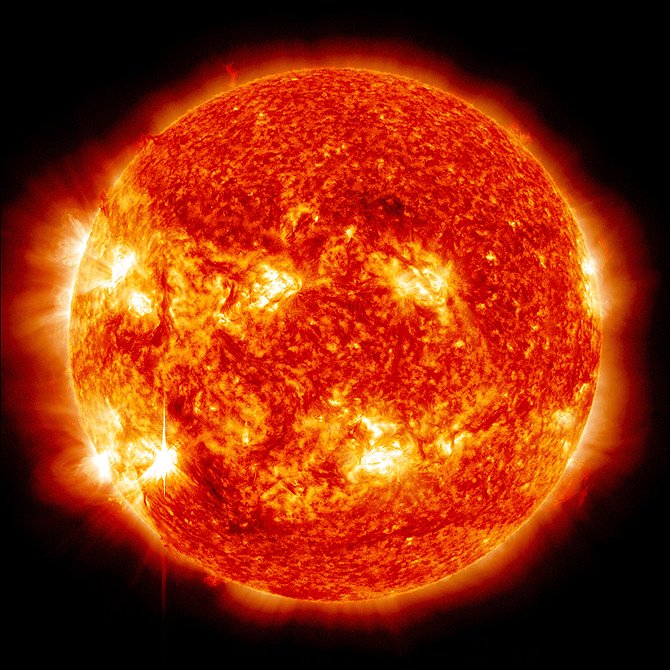Highlights
Stellar measurement by quantum methods
sunlight might be applied to open questions in astrophysics

By filtering light from the sun, CQT researchers have made a strong detection of a quantum effect known as 'photon bunching' in its light. This is a hallmark of the sun radiating like a black body. Image: NASA/SDO
CQT graduate student Tan Peng Kian is celebrating his first paper. In an unusual first for research from the Centre for Quantum Technologies, his work with CQT Principal Investigator Christian Kurtsiefer and collaborators at the National University of Singapore appears in the Astrophysical Journal Letters.
That's because the article demonstrates a novel technique for measuring a quantum-optical effect in light from the sun. Applied to measuring light from more distant stars, the approach could lend data to the search for planets outside our solar system and constrain theories of quantum gravity.
The article, published online 13 June, reports measurement of 'temporal photon bunching' in light from the sun and laboratory test-sources. Photon bunching is a quantum effect known since the 1960s, describing the preference of photons to stay close together.
The sun, for all its fusion-powered complexity, emits radiation like a 'black body' source – that is, like a simple object heated up to a given temperature, with that temperature being all you need to describe the emission.
Enter quantum optics
Black bodies have played a remarkable role in the development of modern physics. Efforts in the early 20th Century to describe the pattern of blackbody radiation contributed to the development of quantum theory. The established wave theory of light failed to predict the observed spectrum – a 'catastrophe' that was resolved by the introduction of the quanta of light we now call photons. Later, when the theory of photon bunching was developed in the 1960s to describe measurements of the 'coherence' of light from black body sources, it was a major contributor to the field of quantum optics.
Peng Kian and his colleagues have now turned the tools of modern quantum optics labs back on black bodies to make coherence measurements with unprecedented sensitivity.
The researchers designed a device with optical components that filter out photons with a very narrow range of wavelengths, which are then channelled to photon detectors. By picking out photons that are similar to each other, the filtering increases the ratio of bunched pairs to background photons. This makes it possible to detect the signal. Detectors known as actively quenched thin avalanche photodiodes register the photons one by one. It's then possible to map how many photons arrive at what intervals, measuring the full signature of the temporal bunching (see figure below).

The device detects photons that arrives in pairs, recording their sepaation. The experimental data (plotted red) are fitted (black line) to a correlation function that describes the relative probability of photons arriving at different intervals of time. Quantum theory predicts that this function g(2) should peak at 2 for blackbody radiation, verus being flat at 1 for incoherent radiation. The CQT experiment clearly measures g(2) exceeding 1, the signature of photon bunching. Figure: Astrophysical Journal Letters 789:L10 (2014)
Only in the past few years have any techniques been able to measure this temporal effect in blackbody radiation at all, and the device developed by Peng Kian and team makes the strongest measurement yet of the effect in sunlight.
Beyond the sun
Detections of photon bunching are often known as "Hanbury-Brown and Twiss" experiments, after the British astronomers Robert Hanbury Brown and Richard Twiss who performed the first such experiments in the 1950s. They later developed the technique as an astronomical tool. By pointing a pair of telescopes at a star, they would estimate the star's angular width by distinguishing the coherent light from the random background. However, the technique's usefulness was limited by the signal to noise ratio.
With today's improved tools, there is revived interest in doing optical intensity interferometry to determine stellar sizes. One reason is to better calculate the sizes of exoplanets detected by periodic dimming of a star's brightness.
Direct measurements of the temporal bunching can also distinguish different types of emission. For example, it has been suggested that massive stars known as Wolf-Rayet stars may not emit only as black bodies, but also emit light through a laser mechanism. Coherence measurements could distinguish laser emission from blackbody emission.
It is even possible that measuring light reaching us from stars far, far away could tell us about photons losing their coherence across vast distances in space. Such a detection could constrain theoretical models of quantum gravity that make predictions about decoherence.
But that's getting a little ahead. "Our experiment is a proof-of-concept," says Peng Kian. "I find it very interesting that we could do something in astrophysics, but first we have to show it works for stars other than the Sun. We still have some problems to solve, such as improving the signal to noise."
For the solar light measurements described in the paper, Peng Kian set up a small telescope on an aerial bridge connecting CQT to a neighbouring building. The light collected by the telescope went down an optical fibre, four stories and one corridor along, to reach his setup in the lab. The device was built to be portable, and Peng Kian hopes that he will soon be able to test it at a telescope in Singapore.
"It's fun to make this excursion into another field," says Christian, an expert in quantum optics who co-supervises Peng Kian with NUS Associate Professor Phil Chan.
There's evidence that the excursion will be welcomed by the other side, too. Peng Kian has struck up a collaboration with astronomers at a telescope in Italy. He also presented his work in May at an international conference in France that brought together astronomers and quantum physicists.
For more details, see "Measuring temporal photon bunching in blackbody radiation", Astrophysical Journal Letters, 789:L10 (2014); arXiv:1403.7432.






